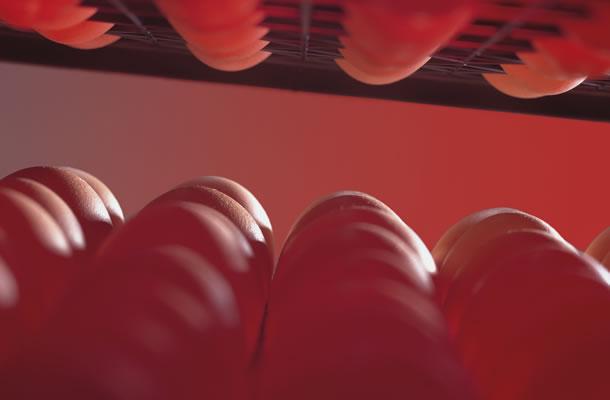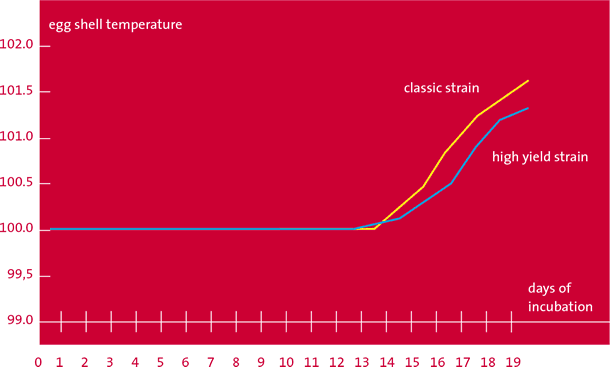Finding optimum incubation temperature
Tags: Incubation | Whitepaper
, August 27 2012

When a hatchery manager talks about incubation temperature, he or she refers to the temperature set point at the controller of the incubator. This temperature set point regulates the temperature of the air stream along the incubator’s temperature sensors. If the air temperature is too high or too low, the incubator controller adjusts the cooling or heating rates respectively, until temperature set point is reached.
Thus, incubation temperature is dictated by the air temperature surrounding the sensor. However, the hatchery manager knows that there is a critical relationship between incubation temperature, hatchability and chick quality.
Optimum egg shell temperatures
The key parameter for achieving optimum embryonic development is embryonic temperature, represented by the temperature of the egg shell.
From recent research, we know that shell temperature should ideally follow a natural pattern ( see figure). During the first 12 days of incubation, optimum shell temperature is 37.8 ± 0.1 ˚C (100 ± 0.2 ˚F), followed thereafter by a gradual increase to 38.4 - 38.6 ± 0.2 ˚C (101.1 - 101.5 ± 0.4 ˚F) at day of transfer. From practical experience, we also know that during the first 12 days of incubation, optimum shell temperature varies little between embryos from different poultry strains. Towards the end of the incubation period, however, there are significant variations in the optimum maximum shell temperature for different strains: normal maximum shell temperature for the classic breeds are too high for embryos from modern high yield breeds, resulting in poor quality chicks with poor navels and red dots on the beak.
Optimum incubation temperatures
Egg shell temperature is determined by a combination of the metabolic heat produced by the embryos and the climate (temperature, air flow, humidity) surrounding the eggs. In the early phase of embryonic development, very little metabolic heat is produced and the air surrounding the eggs should be heated to keep egg shell temperature at optimum levels. But towards the end of incubation, the production of metabolic heat increases - and this heat must be removed by cooled air flowing over the eggs to avoid the risk of overheating the developing embryos.
Advice
- Define optimum incubation temperatures by measuring the egg shell temperatures of a representative sample of eggs, randomly chosen from different trays in the incubator.
- Do not copy guidelines for optimum incubation temperatures from one brand of incubators to another. Airflow patterns differ between different incubator designs.
- Limit the number of trolleys in front of the fan or air pump to a maximum of two. This guarantees a uniform airflow and even temperature distribution over the eggs.
- Use chick quality as a reference, especially if egg shell temperatures cannot be measured at a regular base.
- Perform a detailed analysis of chick quality (Pasgar©score) to avoid accidental conclusions on overheating. If ≤ 50 % of chicks have a fully closed, normal navel and 10% of chicks have a red dot on the beak, reduce the incubation temperature.
- Increase incubation temperatures if day old chick quality indicates an incubation temperature that is too low. This applies if ≤ 50 % of chicks have a fully closed normal navel and 20 % have a thick belly (large yolk sac), upon detailed analysis of chick quality (Pasgar©score).

Natural pattern of egg shell temperatures for optimum hatchabilities and chick qualities